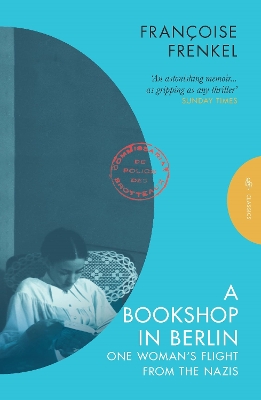Reviewed by Michael @ Knowledge Lost on
This memoir gives an account of part of her life, from opening Berlin’s first specialist French bookstore in 1921 to her experience with the rise of the Nazi party. Françoise Frenkel, like many other Jewish people, suffered greatly, but what fascinated me about No Place to Lay One’s Head is what she left out of the book. There is no mention of her husband in Rien où poser sa tête at all. The only reason I know about his existence is because of the timeline in the back of the book.
Grief is a powerful emotion and people find their own ways to deal with the pain. Looking at this timeline I know that Frenkel and her husband Simon Raichenstein opened Maison du Livre français (which means House of the French Books) together. He was deported (due to the fact he was a Belarusian) and lived in France from 1933, until he was arrested in 1942 and sent to Auschwitz, where he was murdered. Françoise Frenkel ran the bookstore alone until she escaped Germany in 1939. I do not know if the two spent reunited in France, but I suspect that they may have. My suspicions are based on this idea of grief; Frenkel started writing No Place to Lay One’s Head in 1943 after she was able to so escape to Switzerland, and I get the feeling that the anger and sadness that comes through in the book might have been related to the one person she cannot bare to talk about.
I picked up this book in the hopes to explore the life of a specialist book seller in a rapidly changing political climate but I got something different. I would have loved more chapters on her time learning the trade in a second hand bookstore in the Rue Gay-Lussac. Or even exploring the idea of opening a specialist French bookshop in Germany and the impact it had. Maybe even something that compared the idea to Sylvia Beach opening Shakespeare and Company (a specialty book store dedicated to English language books) in France two years earlier. I love books about books and thought these would be some interesting topics to explore. However I got something completely different; something so devastating and yet full of beauty.
I am partial to a book that is able to deliver cruelty and shock in such an elegant way and I think No Place to Lay One’s Head was able to do just that. It is a weird feeling to go into a book hoping for one thing but finding something unexpected. This memoir is heartbreaking and to try and understand everything she was not saying, just made this book even more affecting. In the back of the book there is one picture of a dedication she wrote to a priest. “…I would be so grateful for your prayers – I seek inner peace; I am grieving for so many and know not where my family have been laid to rest.” I think that sums up the feeling Françoise Frenkel must have had when writing No Place to Lay One’s Head.
This review originally appeared on my blog; http://www.knowledgelost.org/book-reviews/genre/non-fiction/no-place-lay-ones-head-francoise-frenkel/
Reading updates
- Started reading
- 26 July, 2017: Finished reading
- 26 July, 2017: Reviewed
